+ Open data
Open data
- Basic information
Basic information
| Entry | Database: PDB / ID: 7p9v | |||||||||||||||||||||||||||||||||
|---|---|---|---|---|---|---|---|---|---|---|---|---|---|---|---|---|---|---|---|---|---|---|---|---|---|---|---|---|---|---|---|---|---|---|
| Title | Cryo EM structure of System XC- | |||||||||||||||||||||||||||||||||
 Components Components |
| |||||||||||||||||||||||||||||||||
 Keywords Keywords | MEMBRANE PROTEIN / transporter glutamate cystine | |||||||||||||||||||||||||||||||||
| Function / homology |  Function and homology information Function and homology informationcystine:glutamate antiporter activity / regulation of neutrophil apoptotic process / L-kynurenine transmembrane transport / L-kynurenine transmembrane transporter activity / regulation of cysteine metabolic process / regulation of glutathione biosynthetic process / regulation of glutamate metabolic process / regulation of melanin biosynthetic process / regulation of AMPA glutamate receptor clustering / L-cystine transport ...cystine:glutamate antiporter activity / regulation of neutrophil apoptotic process / L-kynurenine transmembrane transport / L-kynurenine transmembrane transporter activity / regulation of cysteine metabolic process / regulation of glutathione biosynthetic process / regulation of glutamate metabolic process / regulation of melanin biosynthetic process / regulation of AMPA glutamate receptor clustering / L-cystine transport / Defective SLC7A7 causes lysinuric protein intolerance (LPI) / neutral L-amino acid secondary active transmembrane transporter activity / apical pole of neuron / aromatic amino acid transmembrane transporter activity / tyrosine transport / L-histidine transport / amino acid transport complex / dipeptide import across plasma membrane / L-leucine import across plasma membrane / L-alanine transmembrane transporter activity / L-alanine import across plasma membrane / regulation of protein transport / isoleucine transport / phenylalanine transport / methionine transport / L-amino acid transmembrane transporter activity / valine transport / L-leucine transmembrane transporter activity / calcium:sodium antiporter activity / L-leucine transport / thyroid hormone transport / proline transport / L-glutamate transmembrane transport / glutathione transmembrane transport / amino acid transmembrane transport / regulation of cellular response to oxidative stress / ventricular system development / lens fiber cell differentiation / intracellular glutamate homeostasis / Amino acid transport across the plasma membrane / neutral L-amino acid transmembrane transporter activity / L-glutamate import across plasma membrane / Tryptophan catabolism / striatum development / astrocyte projection / exogenous protein binding / anchoring junction / limb development / Basigin interactions / negative regulation of ferroptosis / response to redox state / microvillus membrane / NFE2L2 regulating anti-oxidant/detoxification enzymes / lung alveolus development / amino acid transport / regulation of synapse organization / adult behavior / response to exogenous dsRNA / tryptophan transport / glutathione metabolic process / basal plasma membrane / response to nicotine / brush border membrane / modulation of chemical synaptic transmission / visual learning / response to organic cyclic compound / platelet aggregation / response to toxic substance / calcium ion transport / double-stranded RNA binding / melanosome / apical part of cell / virus receptor activity / regulation of cell population proliferation / cellular response to oxidative stress / basolateral plasma membrane / carbohydrate metabolic process / cadherin binding / symbiont entry into host cell / protein heterodimerization activity / apical plasma membrane / lysosomal membrane / synapse / cell surface / protein homodimerization activity / RNA binding / extracellular exosome / nucleoplasm / membrane / plasma membrane Similarity search - Function | |||||||||||||||||||||||||||||||||
| Biological species |  Homo sapiens (human) Homo sapiens (human) | |||||||||||||||||||||||||||||||||
| Method | ELECTRON MICROSCOPY / single particle reconstruction / cryo EM / Resolution: 3.4 Å | |||||||||||||||||||||||||||||||||
 Authors Authors | Parker, J.L. / Deme, J.C. / Lea, S.M. / Newstead, S. | |||||||||||||||||||||||||||||||||
| Funding support |  United Kingdom, 10items United Kingdom, 10items
| |||||||||||||||||||||||||||||||||
 Citation Citation |  Journal: Nat Commun / Year: 2021 Journal: Nat Commun / Year: 2021Title: Molecular basis for redox control by the human cystine/glutamate antiporter system xc. Authors: Joanne L Parker / Justin C Deme / Dimitrios Kolokouris / Gabriel Kuteyi / Philip C Biggin / Susan M Lea / Simon Newstead /   Abstract: Cysteine plays an essential role in cellular redox homoeostasis as a key constituent of the tripeptide glutathione (GSH). A rate limiting step in cellular GSH synthesis is the availability of ...Cysteine plays an essential role in cellular redox homoeostasis as a key constituent of the tripeptide glutathione (GSH). A rate limiting step in cellular GSH synthesis is the availability of cysteine. However, circulating cysteine exists in the blood as the oxidised di-peptide cystine, requiring specialised transport systems for its import into the cell. System xc is a dedicated cystine transporter, importing cystine in exchange for intracellular glutamate. To counteract elevated levels of reactive oxygen species in cancerous cells system xc is frequently upregulated, making it an attractive target for anticancer therapies. However, the molecular basis for ligand recognition remains elusive, hampering efforts to specifically target this transport system. Here we present the cryo-EM structure of system xc in both the apo and glutamate bound states. Structural comparisons reveal an allosteric mechanism for ligand discrimination, supported by molecular dynamics and cell-based assays, establishing a mechanism for cystine transport in human cells. | |||||||||||||||||||||||||||||||||
| History |
|
- Structure visualization
Structure visualization
| Movie |
 Movie viewer Movie viewer |
|---|---|
| Structure viewer | Molecule:  Molmil Molmil Jmol/JSmol Jmol/JSmol |
- Downloads & links
Downloads & links
- Download
Download
| PDBx/mmCIF format |  7p9v.cif.gz 7p9v.cif.gz | 173.1 KB | Display |  PDBx/mmCIF format PDBx/mmCIF format |
|---|---|---|---|---|
| PDB format |  pdb7p9v.ent.gz pdb7p9v.ent.gz | 138.4 KB | Display |  PDB format PDB format |
| PDBx/mmJSON format |  7p9v.json.gz 7p9v.json.gz | Tree view |  PDBx/mmJSON format PDBx/mmJSON format | |
| Others |  Other downloads Other downloads |
-Validation report
| Summary document |  7p9v_validation.pdf.gz 7p9v_validation.pdf.gz | 1.2 MB | Display |  wwPDB validaton report wwPDB validaton report |
|---|---|---|---|---|
| Full document |  7p9v_full_validation.pdf.gz 7p9v_full_validation.pdf.gz | 1.2 MB | Display | |
| Data in XML |  7p9v_validation.xml.gz 7p9v_validation.xml.gz | 43.3 KB | Display | |
| Data in CIF |  7p9v_validation.cif.gz 7p9v_validation.cif.gz | 59.7 KB | Display | |
| Arichive directory |  https://data.pdbj.org/pub/pdb/validation_reports/p9/7p9v https://data.pdbj.org/pub/pdb/validation_reports/p9/7p9v ftp://data.pdbj.org/pub/pdb/validation_reports/p9/7p9v ftp://data.pdbj.org/pub/pdb/validation_reports/p9/7p9v | HTTPS FTP |
-Related structure data
| Related structure data |  13267MC  7p9uC C: citing same article ( M: map data used to model this data |
|---|---|
| Similar structure data |
- Links
Links
- Assembly
Assembly
| Deposited unit | 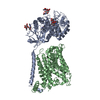
|
|---|---|
| 1 |
|
- Components
Components
| #1: Protein | Mass: 69161.867 Da / Num. of mol.: 1 Source method: isolated from a genetically manipulated source Source: (gene. exp.)  Homo sapiens (human) / Gene: SLC3A2, MDU1 / Production host: Homo sapiens (human) / Gene: SLC3A2, MDU1 / Production host:  Homo sapiens (human) / References: UniProt: P08195 Homo sapiens (human) / References: UniProt: P08195 | ||
|---|---|---|---|
| #2: Protein | Mass: 56466.605 Da / Num. of mol.: 1 Source method: isolated from a genetically manipulated source Source: (gene. exp.)  Homo sapiens (human) / Gene: SLC7A11 / Production host: Homo sapiens (human) / Gene: SLC7A11 / Production host:  Homo sapiens (human) / References: UniProt: Q9UPY5 Homo sapiens (human) / References: UniProt: Q9UPY5 | ||
| #3: Polysaccharide | 2-acetamido-2-deoxy-beta-D-glucopyranose-(1-4)-2-acetamido-2-deoxy-beta-D-glucopyranose Source method: isolated from a genetically manipulated source Has ligand of interest | N | |
-Experimental details
-Experiment
| Experiment | Method: ELECTRON MICROSCOPY |
|---|---|
| EM experiment | Aggregation state: PARTICLE / 3D reconstruction method: single particle reconstruction |
- Sample preparation
Sample preparation
| Component | Name: System XC- / Type: COMPLEX / Entity ID: #1-#2 / Source: RECOMBINANT |
|---|---|
| Source (natural) | Organism:  Homo sapiens (human) Homo sapiens (human) |
| Source (recombinant) | Organism:  Homo sapiens (human) Homo sapiens (human) |
| Buffer solution | pH: 7.5 |
| Specimen | Embedding applied: NO / Shadowing applied: NO / Staining applied: NO / Vitrification applied: YES |
| Vitrification | Cryogen name: ETHANE |
- Electron microscopy imaging
Electron microscopy imaging
| Experimental equipment |  Model: Titan Krios / Image courtesy: FEI Company |
|---|---|
| Microscopy | Model: FEI TITAN KRIOS |
| Electron gun | Electron source:  FIELD EMISSION GUN / Accelerating voltage: 300 kV / Illumination mode: FLOOD BEAM FIELD EMISSION GUN / Accelerating voltage: 300 kV / Illumination mode: FLOOD BEAM |
| Electron lens | Mode: BRIGHT FIELD |
| Image recording | Electron dose: 59.1 e/Å2 / Film or detector model: GATAN K3 BIOQUANTUM (6k x 4k) |
- Processing
Processing
| Software | Name: PHENIX / Version: 1.18.2_3874: / Classification: refinement | ||||||||||||||||||||||||
|---|---|---|---|---|---|---|---|---|---|---|---|---|---|---|---|---|---|---|---|---|---|---|---|---|---|
| CTF correction | Type: PHASE FLIPPING AND AMPLITUDE CORRECTION | ||||||||||||||||||||||||
| Symmetry | Point symmetry: C1 (asymmetric) | ||||||||||||||||||||||||
| 3D reconstruction | Resolution: 3.4 Å / Resolution method: FSC 0.143 CUT-OFF / Num. of particles: 300221 / Symmetry type: POINT | ||||||||||||||||||||||||
| Refine LS restraints |
|
 Movie
Movie Controller
Controller




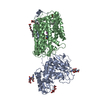


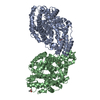
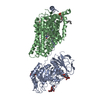

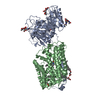

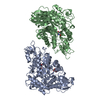
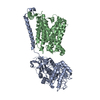
 PDBj
PDBj



